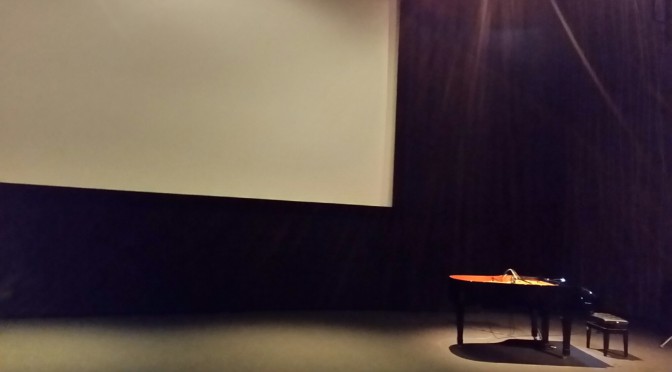Amsterdam’s cultural life has once again offered something quite thought provoking and of course I’d like to share the products of my grey cells with you. I’ve discussed music and/in film here already earlier but this latest experience provides yet another angle to the topic.
The Amsterdam film museum Eye presented the Japanese silent film The Story of Floating Weeds (Ukikusa monogatari) from 1934 with introduction and piano accompaniment by Martin de Ruiter and voice acting (benshi) by Ichiro Kataoka.
“Floating weeds, drifting down the leisurely river of our lives,” has long been a favored metaphor in Japanese prose and poetry. Donald Richie
The film tells a story of a man leading a theatre troupe and being torn between his responsibilities as a father and the demands of his nomadic profession. For a more elaborate plot description and analysis, see this blog text on Silent Volume.
Silent film in Japan
In the introduction to the cinema concert Mr de Ruiter told us that in Japan silent films were made considerably longer than in the US and Europe. Whereas in the US the last silent films where made in the end of 1920s and e.g. in the Netherlands Philips was able to equip the Dutch cinemas with sound systems very quickly in the 1930s, in Japan silent films were made until the 1940s.
It is also notable that the Japanese silent film making owed much to the Noh theatre tradition. The director of the afternoon’s film Yasujiro Ozu bowed to the old tradition by using a rather stationary camera positioning, which according to David Bordwell is Ozu’s stylistic trademark. There were very few scenes where the camera would actually follow a person or close up. I’m not an expert here but seems to me that Ozu’s work belongs to the Pure Film Movement of early Japanese cinema.
Here’s a short clip from the film to give you a better idea what I’m talking about here.
In addition to being stationary and showing mostly the whole set of a scene, Ozu’s style of shooting also viewed the actor from a point of view similar to that of a theatre audience; from slightly below, always showing the full bodies of the actors – including their geta, Japanese version of flip-flops. In the few close-ups at the most dramatic moments the actors didn’t show there emotions so much on there faces as with their hands and other bodily gestures. There was a lot of scratching and touching different body parts as a reaction to e. g. an accusation or embarrassment.

This, in my view, is in line with the above-mentioned debt to the Noh theatre in which the actors wore masks.

Dramatising a story
Old films, let alone films from other cultures, tend to use different strategies and methods to dramatise their stories. Most notably there are differences in the amount of time taken and details used to build up the story line and highlight the dramatic climaxes.
In this cinema concert, however, the drama began from the setting you see in the picture on the top: An empty screen and empty piano chair. Outside of the picture on the left there’s also a speakers stand for the voice actor. In other words, the setting was full of potential but provided few cues as to what was to come – which of course is the case in most performances.
Not being at all familiar with Japanese silent film before this experience, I could only expect what I had read in the short description on the EYE website.
Power of silence
I couldn’t find any information about the piano music Mr de Ruiter played that night, but I’m quite sure it wasn’t the same composition heard on the clip above. Whereas the music of this clip sounds like quite typical late Romantic piano music (not quite my cup of tea so I can’t name the composition), the music Mr de Ruiter played was more serene, even abstract at times, and used a lot of pentatonic scales giving it an “Eastern” flavour.
Although Mr de Ruiter has composed music for silent films and is the programmer for “silent film and live music” at the EYE, I couldn’t find confirmation to whether he had actually composed the music we heard that afternoon.
One of the most dramatic moments in The Story of Floating Weeds was when the troupe was sitting together for the last time and began singing, trying to enjoy this last moment together. The drama of the moment was highlighted – one might even say created – by the pause in the piano accompaniment. This left us watching the silent singing and hand clapping of the people on the screen – and indeed for one of them it was too much and he broke off crying.
I found that a very strong moment with much more profound effect as in your standard Hollywood build-up with more and more action and louder music/sound effects. It was also a bold move from the composer. The music until then – and after this scene – was indeed more like an accompaniment; moving with the action on the screen, sort of mimicking it.
By dropping the accompaniment out when the people on the screen were singing, music – for a moment – gained agency in the dramatisation of the story. The sudden absence of the music, just when the people were singing and in need of accompaniment, turned our focus on the (absence of) music as well as on the dramatic moment; the the film characters were forcing themselves to sing, although most of them felt like crying. One could also say that music assumed a personage of its own as one of the singers on the screen who – like one of the figures actually did – couldn’t go on singing but had to break off.











